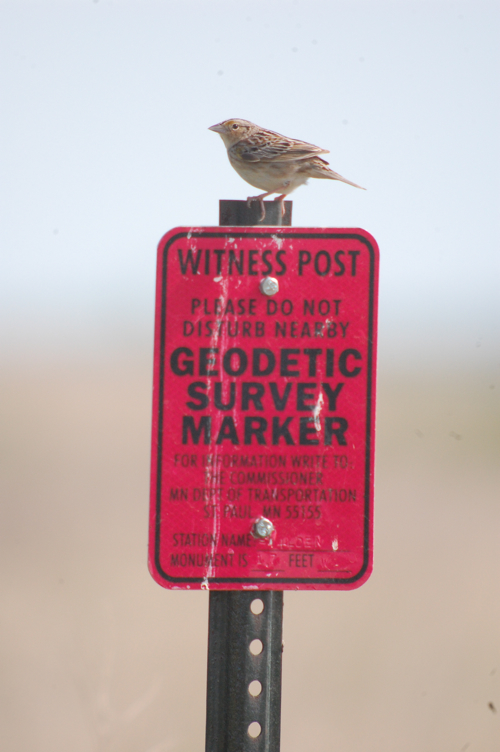 A grasshopper sparrow toes the line with authorities be pooping on the geodetic sign...what is a geodetic survey anyway?
A grasshopper sparrow toes the line with authorities be pooping on the geodetic sign...what is a geodetic survey anyway?
Young Red-tail Has Rough Start
I saw this story from KARE 11 of a young red-tailed hawk that crashed into someone's windshield in north Minneapolis on the I-94 Dowling Avenue off-ramp. The person driving, managed to flag down Minneapolis Police Officer Brian Thole who drove it straight away to The Raptor Center. This in and of itself is a nice, heart-warming story. Then I see that as TRC was examining the hawk, they found an old pellet from a gun lodged into it. This is an immature red-tailed hawk--most likely hatched this past April and already it's been hit by a car and shot. Who the heck in the north metro is shooting hawks? Ugh.
TRC is optimistic about this red-tail's recovery thanks to the officer's fast response.
American Birding Association...A Failing Hive?
I'm willing to guess that many of the people who follow along with this blog are not really aware of the American Birding Association. It's supposed to be the binding organization of birders across North America, but in the last decade, it seems more like a once great bird club that is slowly fading away. Here's how the ABA describes itself: The ABA is a non-profit 501(c)(3) organization that provides leadership to birders by increasing their knowledge, skills, and enjoyment of birding. We are the only organization in North America that specifically caters to recreational birders. We also contribute to bird and bird habitat conservation through our varied programs.
I like some of the staff at ABA and 20% of the profits from my online shop goes to their programs for young people--I think they programs for kids are great and had I been aware of them when I was a kid, I would have wanted to go.
Last week,I received a note that the ABA was looking to hire another President. When I read it, I thought, "Again?" The ABA had just dumped one president because the organization was bleeding members and failing and hired a new guy who was supposed to be the great white hope of the organization. As soon as the ABA job opening came out, rumors about why the latest president was fired had words like "mismanagement" and "embezzlement" surrounding them.
T0 me, the ABA seems like a failing hive. The queen failed and the hive started loosing workers, they tried to create a new workforce, but only produced drones who do nothing to help build up the hive. A requeening was attempted and failed...should another queen be introduced?
Some, like Kenn Kaufman have loyalty to the ABA because he was there in the halcyon days of the 1970s when it was exciting, coming together and growing--birders finally had a chance to connect on a country wide basis. I do not have this loyalty. I wasn't even aware of it until the mid 1990s. I enjoyed some of the publications and I enjoyed the festivals when I could afford to go (or go on someone's behalf like Swarovski). But I had no way of knowing about it as a kid growing up in Indiana.
But now many question if it's too late for the organization--should it die? Or should we try to requeen this hive and save it.
There's lots of discussion about why the ABA is failing.
Can't compete with the Internet: ABA brought birders together before there was the Internet. Now that there are blogs, forums, state list sites, Facebook, Twitter, etc--people are more interested in their local patch, rather than a big organization that talks about gulls on the west coast than grosbeaks in the backyard. It was slow to embrace the Internet and has really grown in the last year, thanks to a few forward thinking staff.
Birders Don't Get Along: There are different types of birders and they can't get along well enough to even partner up for conservation efforts (Duck Stamp, anyone). Hardcore birders want the ABA to be id and listing and I would wager that though a vocal group, they are the smallest percentage of birders in the US. Casual birders are intimidated and sometimes bored by the finer points of ID but they are a much larger group and would greatly increase membership and cash flow. Currently, the ABA can't seem to find a way to please both.
Offerings Priced Out Of The Market: The trips and workshops offered by the ABA are too cost prohibitive for the average person and suffer from competition from all the other bird festivals out there. I think the bird festival business model needs to be overhauled, many bird festivals are faltering not only because of the economy but because many festival organizers don't quite know how to price things and market them in a sustainable way.
The Board of Directors: Some say the whole board should resign because their actions of the last two years led to its fast failure. I don't know too many of the board members--which is weird, I get around, I travel all over the country and meet a lot of birders, but not many on the ABA board. I think it might be interesting to add some fresher and younger blood on the board. Perhaps someone Mike Bergin from 10,000 Birds who was one of the first bird bloggers, has been ahead on the bird blogging curve and using the website as means of raising money for conservation and keeping the bird community informed rather than someone who is a Hollywood actress who happens to be a birder. I'd also be in favor of getting someone who was a higher up at Ducks Unlimited on the board to help build an organization that cannot only bring birders together but turn it into a voice to be listened to at Congress and raise money for habitat.
Ever since I've been aware of the ABA, people have been asking, "Can this organizaiton be saved?"
Is it better to get a new president or let this hive die and start a whole new organization?
Shorebird Workshop
Quick note: I'll be on Showcase Minnesota this morning between 10am - 11am answering your birding questions! I got an email from my buddy Doug Buri in Milbank, SD that he's had a few cancellations and has space available on his shorebird identification workshop. This is one of the best birding workshops I have ever attended. Doug literally gets you within five feet of least sandpipers and his easy going and fun techniques will have you sorting your way through the common peeps seen in the midwest.

It's fairly inexpensive to stay in Milbank which is just over the Minnesota border and Doug will take you to some gorgeous remote mudflats. This is a great place to get photos of shorebirds because Doug wants you to get the birds in the best light for id which also means they are in great light for photos. I digiscoped the crap out of the area! The workshop is in early August and details can be found here.
Henderson, MN Hummingbird Festival
Well who knew--a hummingbird festival in Minnesota? We may only have one species of hummer in this state but the town of Henderson, MN is gonna make the most of it by hosting the Henderson Hummingbird Hurrah August 27 -28, 2010. The festival features workshops on how to attract hummingbirds, how to photograph them, a vender area and of great interest to me--hummingbird banding! It's not too far out of the Twin Cities and a fun way to spend time in late August (a great time to watch ruby-throated hummingbirds in this state--right smack in the middle of migration, so though it's only one species, there will be tons of them.
Farmers Asked To Flood Fields For Migratory Birds #oilspill
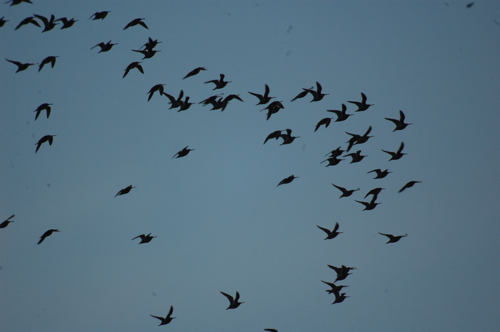 It's July. Shorebird migration is upon us. That's right, bird migration starts in July as shorebirds (like the above dowitchers) leave their breeding grounds in the Arctic, work their way down south. In Minnesota, we'll see more shorebirds towards the end of the month and into August as they forage in flooded fields and sod farms. For many of us who love these birds, this will be bittersweet as we watch them, knowing they are headed south to the Gulf of Mexico. These birds have no idea of what they are flying into and the dangerous oil covered forage they will find (if they find food at all, who knows what will be available after the die off kicks in).
It's July. Shorebird migration is upon us. That's right, bird migration starts in July as shorebirds (like the above dowitchers) leave their breeding grounds in the Arctic, work their way down south. In Minnesota, we'll see more shorebirds towards the end of the month and into August as they forage in flooded fields and sod farms. For many of us who love these birds, this will be bittersweet as we watch them, knowing they are headed south to the Gulf of Mexico. These birds have no idea of what they are flying into and the dangerous oil covered forage they will find (if they find food at all, who knows what will be available after the die off kicks in).
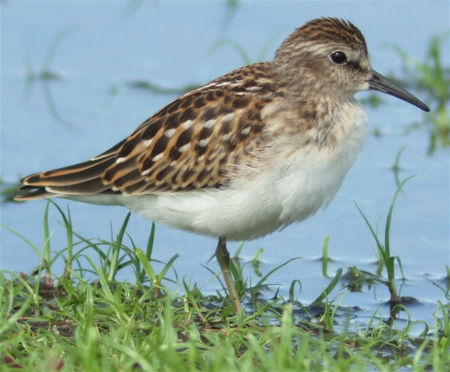
In an effort to help birds like the above least sandpiper (which are about the size of a warbler) a federal conservation agency is asking farmers in 8 states to flood their fields to create migration habitat for the birds to fuel up on food for their long journey. From the L.A. Times:
The Migratory Bird Habitat Initiative will pay to use up to 150,000 acres of land "to provide feeding, loafing and resting areas for migratory birds," according to an announcement by the Agriculture Department's Natural Resources Conservation Service.
The program applies mainly to former wetlands and low-lying land in Alabama, Arkansas, Florida, Georgia, Louisiana, Mississippi, Missouri and Texas. Conservation officials are hoping to attract birds to safe areas before they land on shores and wetlands contaminated by the massive oil spill.
Landowners would be expected to flood fields and promote the growth of vegetation favored by migratory birds, or to enhance existing wetlands on their properties, for three to five years, said NRCS spokeswoman Chris Coulon.
Rice fields and fish farms are particularly suited to the initiative.
For birds, "it's an alternative so they'll have a lower probability of landing in areas affected by the oil spill," Coulon said.
Up to $20 million has been allocated for the initiative, but how much actually is spent depends on farmers' response, she said.
Will this actually work? Who can say, but it can't be a bad thing to improve migratory bird habitat regardless of an oil spill.
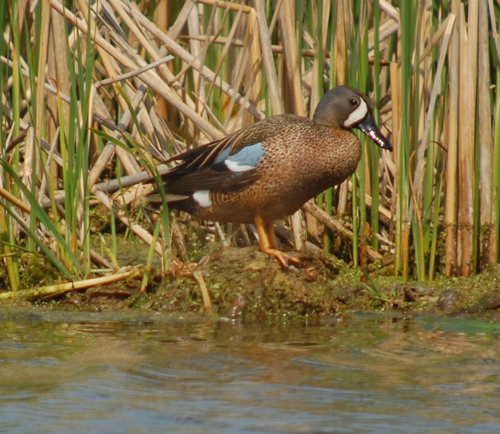
It's not just shorebirds that will benefit from this. As much as I love shorebirds, I know many average people have little idea that these birds exist, let alone visit and in some cases breed in Minnesota. This will also benefit many species of ducks like the above blue-winged teal as well as warblers, hummingbirds, orioles, buntings--all sorts of birds that feed in similar habitat to ducks and can be found in our backyards.
Do you know any relatives or friends of the family with farms in these states? Touch base with them, find out if they are aware of the program and if they are willing to sign up.
Random Rose-breasted Grosbeaks
 I don't know about you, but the rose-breasted grosbeaks seem uber abundant this year. We always see a few at Mr. Neil's feeders in the summer, but this year there is a steady flock jockeying for position at the feeders all day long. Our grosbeaks seem to prefer the black oilers, the sunflowers out of the shell and safflower. Anyone else feel like they are seeing more rose-breasted grosbeaks than usual?
I don't know about you, but the rose-breasted grosbeaks seem uber abundant this year. We always see a few at Mr. Neil's feeders in the summer, but this year there is a steady flock jockeying for position at the feeders all day long. Our grosbeaks seem to prefer the black oilers, the sunflowers out of the shell and safflower. Anyone else feel like they are seeing more rose-breasted grosbeaks than usual?
This is not a complaint, I'll take excessive grosbeaks any day of the week.
Life With 8 Beehives
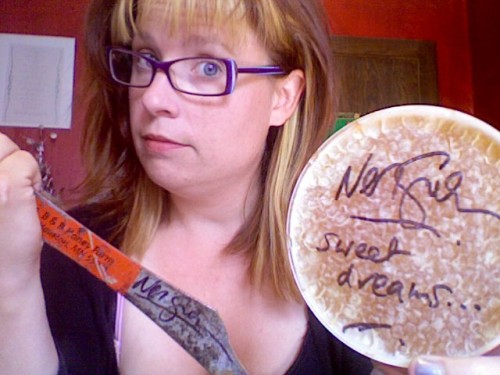 Just an FYI: if you are at CONvergence this weekend, Mr. Neil and I have donated some comb honey and a rusty chipped hive tool (which could be used as a terrifying weapon or shank if one runs in those circles) to the silent auction. Both items have been autographed by Mr. Neil and our comb honey took the blue ribbon at the county fair last year. And the autograph on the honey is actually on the clear plastic case and not on the honey itself.
Just an FYI: if you are at CONvergence this weekend, Mr. Neil and I have donated some comb honey and a rusty chipped hive tool (which could be used as a terrifying weapon or shank if one runs in those circles) to the silent auction. Both items have been autographed by Mr. Neil and our comb honey took the blue ribbon at the county fair last year. And the autograph on the honey is actually on the clear plastic case and not on the honey itself.
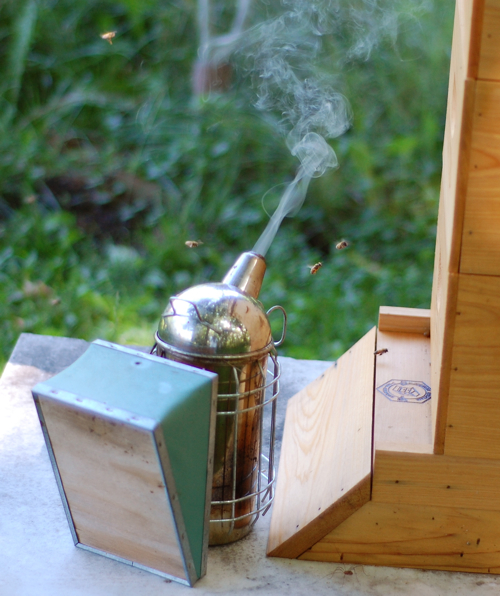
Part of me was kind of freaking out at the idea that we would have 8 beehives this summer, but thanks to the combination of several people on the bee team and a bit more of a "hands off" approach to beekeeping, it's going okay. After our first summer when we took such heroic efforts to keep our two hives going and still had one fail miserably and then last summer leaving a hive I thought was about to fail to do what it will and have it come through the winter stronger than ever, I'm more and more inclined to leg go and let bee.
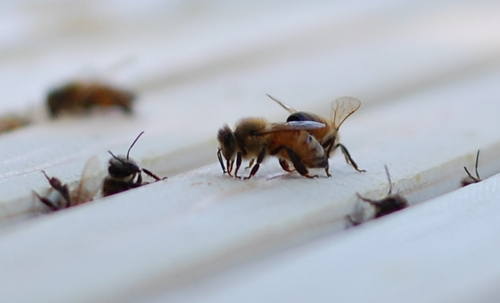
The biggest news to report is that my dear, sweet Non Birding Bill finally got stung--his first time in all the years we've been doing this. As it was his first sting and they tend to be worst, I must say that he took it with much more grace than I did. His ankle was a bit sore and he did have some musings that he was turning into half man/half bee but after I sang a few phrases of Billy the Half A Bee, he decided against it.
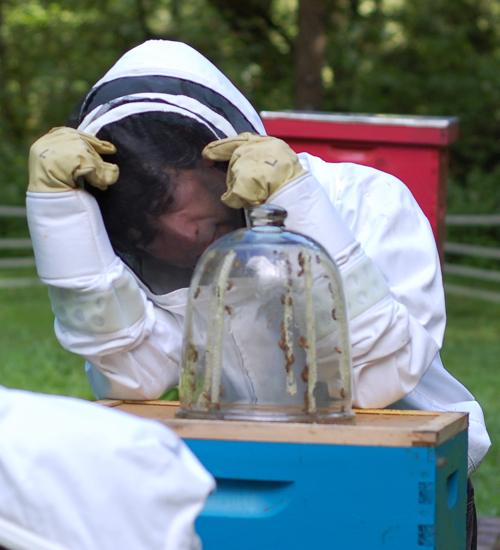
We are attempting the bees in a bell jar feat again. Last summer, the bees removed the starter wax and the jar was full of condensation rather than a cool waxy looking sculpture. Hans thought it might be a good idea to drill some holes in the bell jar to aid in ventilation. We checked on the progress and found bees running around inside the jar.
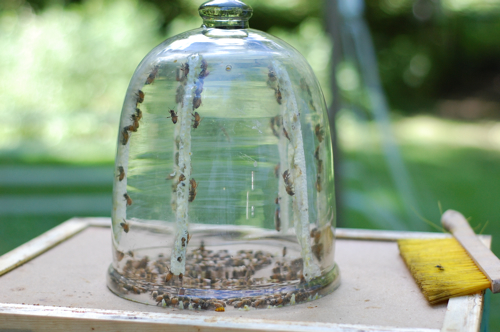
The bell jar bees did what a sensible bee will do with a ventilation hole--they filled it with propolis. After watching all of the activity in the jar, I'm still not certain if they were removing the foundation wax to use in other parts of the hive or seriously drawing it out. Only time will tell, but this hive also has honey supers on it, so if they don't do the bell jar, they will make us some honey.
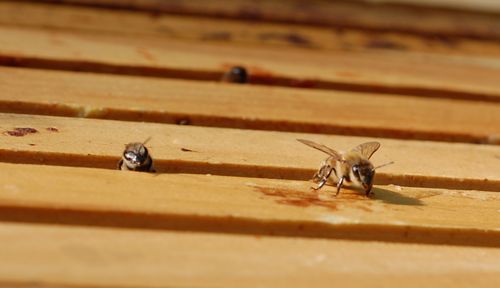
We checked our four new hives and three were excellent. One has had a total queen failure. There's no new brood and no eggs. They have not drawn out comb and filled their box the way the other new hives have--only three frames are full and there appears to be far too many drones--I suspect egg laying workers. Our four hives from the winter were all going strong and it looked like our red hive had recently gone through a swarm. Mr. Neil noted that there were still a few unhatched queen cells in the red hive and suggested we add one to the failing new hive. I was inclined not to but we really had nothing to lose by putting one in. I felt that it would just delay the inevitable end of this new hive but on the other hand--not all of the queen cells would be able to survive in the swarm, so maybe we could give a queen a chance in a new hive.
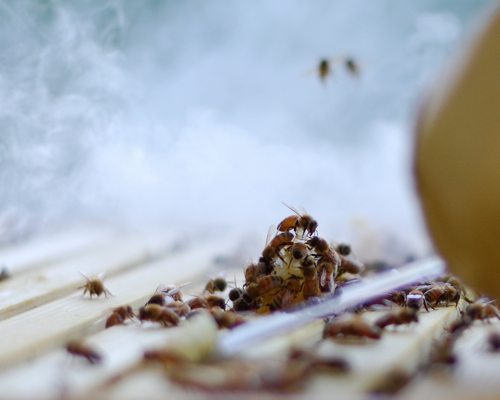
I did notice that when we took out the frame for a queen cell from the red hive that I wasn't seeing much in the way of eggs or young larvae in that hive. I do have a bit of concern for the red hive but that hive seems to know what it's doing. So we put a new queen cell in the failing hive, although without brood, I do not have high hopes it will work. But hey--if we only lose one hive--we still have 7 others going strong.
Odd Goldfinch Again
Last year, I got some video of a goldfinch with a receding cap. It appears to be back with the same lackluster black cap:
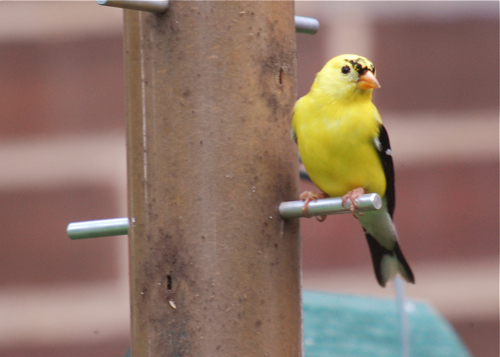
When I watched him all weekend, I didn't see any females hanging out near his perch. I wonder if his mostly yellow cap could do with a little birdy Rogaine?
Minneapolis Flash Flooding 2010
This post is more for my mom than bird related. Tonight we had some flash flooding. Fortunately, Non Birding Bill and I have lived here long enough (and learned the hard way the first year we lived here) that the intersection near our home is prone to flash flooding. Bless NBB's heart, he tried clearing out all the storm drains before the storm to prevent a flash flood, but it hit anyway.

When the worst of the storm was over I went downstairs to see if there was any flooding--there was more than I realized. The police were already on the scene on Lyndale trying to divert traffic away from this street.
 I waded to the infamous intersection that has a tendency to flood--it exceeded my expectations. As I took this photo to show the water flooding 32nd and and Aldric and seeping into a neighbor's yard, I felt the water go from my toes to my mid-calf. It was the first time I experienced how quickly a flash flood hits and why you see people stuck in trees or floating cars unawares--it does happen so fast. Being a short woman around water rising quickly, I knew I needed to move. Since the police were guiding traffic to avoid this intersection from Lyndale, I dashed towards 31st to warn people away.
I waded to the infamous intersection that has a tendency to flood--it exceeded my expectations. As I took this photo to show the water flooding 32nd and and Aldric and seeping into a neighbor's yard, I felt the water go from my toes to my mid-calf. It was the first time I experienced how quickly a flash flood hits and why you see people stuck in trees or floating cars unawares--it does happen so fast. Being a short woman around water rising quickly, I knew I needed to move. Since the police were guiding traffic to avoid this intersection from Lyndale, I dashed towards 31st to warn people away.

I felt so bad for this car. As someone who has had a car go through a flash flood in this intersection, I know what a nasty, stinky mess this car would be. I felt bad for the owner of this vehicle--you could literally see it bob in the water. I was so grateful that our car was parked in a spot that was not experiencing this level of flooding.

As I waded my through, I found more cars caught in the water in the pouring rain. The red car's alarm was going off (and still is now a good three hours later). Neighbors were coming out to gawk at this point and speculate who had a car in the water. I made it to the end of the street and did my best to prevent cars from going down towards the flooded intersection. I wasn't sure how long to stay, but when the rain subsided and visibility was better, I figured that drivers could see well enough and stop before reaching the flooded intersection--there was also quite a crowd gathered at this point as well (leave it to my neighborhood to turn a flash flood into a party). Many were cheering the vehicles that were foolish enough to drive through the water (a moment that many SUV owners live for). NBB and I got a video of it here:
[youtube]http://www.youtube.com/watch?v=ZToej-b1ImY[/youtube]
So, mom, if you hear that there was flooding--yes, we got it in our neighborhood and no, our car or building was not affected.
